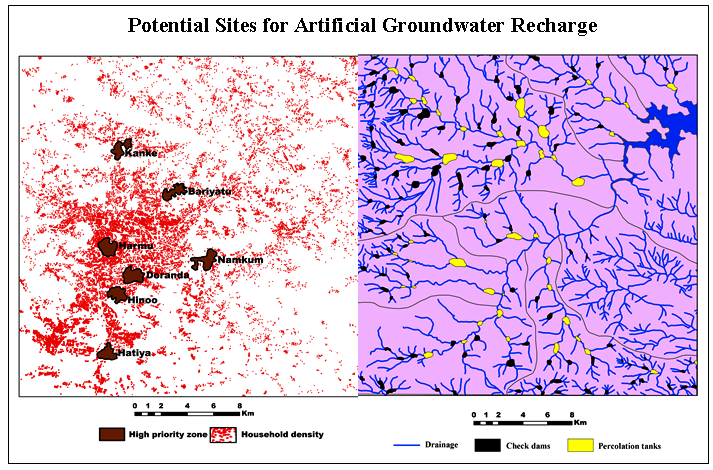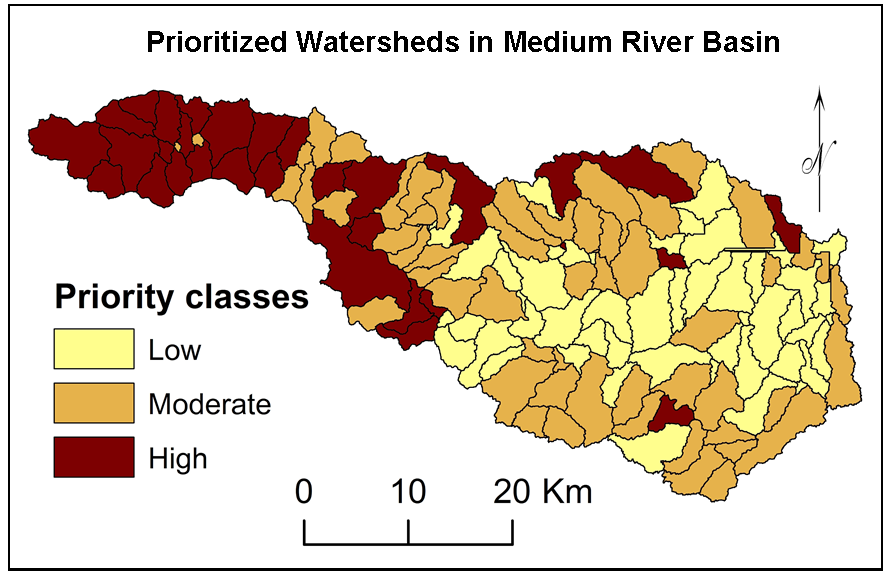Article Title :
Hydrochemical Characterisation and Groundwater Suitability for Drinking and Irrigation uses in Semiarid Region of Nashik Maharashtra India 
Vasant Wagh , Dipak Panaskar , Manesh Aamalawar , Yogesh Lolage , Shrikant Mukate , Narsimha Adimalla
2 (2018)
43-60
Groundwater , hydrochemistry , Drinking , Irrigation , Kadava River


Hydrochemical investigation was undertaken in the Kadava river basin to ascertain the groundwater quality and its suitability for drinking and irrigation purposes. In this context, forty (40) representative groundwater samples were collected from different dug/bore wells based on their importance in drinking and analyzed. Physicochemical parameters like pH, EC and TDS; cations viz., Ca, Mg, Na and K; and anions include CO3, HCO3, SO4, NO3, F, Cl were determined to authenticate the groundwater suitability for drinking. According to BIS, pH (15%), TDS (27.5%), TH (27.5%), Mg (45%), Na (15%), Cl (2.5%), NO3 (52.5%) and F (2.5%) samples exceed the permissible limit (PL); hence, unfit for drinking. The positive loading of TDS and TH is influenced by the content of Mg, Na, Cl and SO4 ions. The increased concentration of Na over Ca corresponds to the ion exchange process. The irrigation indices like SAR, Na (%), RSC, MAR, KR and SSP were considered to evaluate groundwater aptness for irrigation. According to SAR and RSC classification all groundwater samples are suitable for irrigation. MAR ratio suggests 97.5% samples are unfit for irrigation. The study advocates that, those aquifers which are awkward then particular remedial measures required prior to their beneficial use.

Hydro-chemical investigation coupled with groundwater suitability for drinking and irrigation was ascertained in the Kadava river basin.
BIS drinking standards revels that, pH, TDS, TH, Mg, Na, Cl, NO3 and F surpass the permissible limit.
The geogenic processes and anthropogenic inputs are the dominant factors influencing groundwater quality.
SAR and RSC classification indicate that all groundwater samples are suitable for irrigation.
MAR and SSP ratio exhibits that most of the samples are unfit for irrigation.
The outcomes of the study may help to develop compressive groundwater management plans to improve groundwater quality in semi-arid region of basaltic terrain.
Berner, E. K. and Berner, R. A., 1987. Global water cycle: geochemistry and environment. Prentice-Hall.
Davies, S. N. and DeWiest, R. J., 1966. Hydrogeology. Wiley, New York, 1-463.
Doneen, L. D., 1964. Water quality for agriculture. Department of Irrigation, University of Calfornia, Davis.
Drever, J. I., 1988. The geochemistry of natural waters. Prentice Hall, Englewood Cliffs, NJ. The geochemistry of natural waters. 2nd Ed. Prentice Hall, Englewood Cliffs, NJ.
Garrels, R. M. and Christ, C. L., 1967. Equilibres des minéraux et de leurs solutions aqueuses. Gauthier-Villars.
GSI [Geological Survey of India], 2001. District resource Map. GSI, Nashik district.
Jankowski, J., Acworth, R.I. and Shekarforoush, S., 1998. Reverse ion exchange in a deeply weathered porphyritic dacite fractured aquifer system, Yass. In New South Wales Australia. In: Arehart GB, Hulston JR (eds) Proceedings of 9th international symposium on water–rock interaction, Taupo, New Zealand, 30, 243-246.
Kale, S. S., and Pawar, N. 2012. Origin of salinity in the groundwater of semi-arid Karha Basin, Maharashtra. Memoir Geological Society of India, 80, 145-166.
Karanth, K. R., 1987. Groundwater assessment: development and management. Tata McGraw-Hill Education.
Kelley, W. P., 1951. Alkali soils-Their formation, properties and reclamation. Reinhold Publication, New York.
Kirda, C., 1997. Assessment of irrigation water quality. Options Mediterraneennes. Serie A: Seminaires Mediterraneens (CIHEAM).
Krumbein, W.C. and Graybill, F.A., 1965. An introduction to statistical models in geology. McGraw-Hill.
Mertler, C. A. and Vannatta, R. A., 2005. Advanced and multivariate statistical methods. Glendale.
Mukate, S. V., Panaskar, D. B., Wagh, V. M. and Pawar, R. S., 2015. Assessment of groundwater quality for drinking and irrigation purpose: A case study of Chincholikati MIDC area, Solapur (MS), India. SRTMUs J. Sci., 4(1), 58-69.
Mukherjee, S., Kumar, B. A., and Koertvelyessy, L., 2005. Assessment of groundwater quality, South 24-Parganas, West Bengal Coast. India. Journal of Environmental Hydrology, 37(1), 31-40.
Panaskar, D. B., Wagh, V. M. and Pawar, R. S., 2014. Assessment Of Groundwater Quality For Suitability Of Domestic And Irrigation From Nanded Tehsil, Maharashtra, India. SRTMUs J. Sci., 3(2), 71-83.
Pandith, M., Kaplay, R. D., Potdar, S. S., Sangnor, H. and Rao, A.D., 2017. Impact of urbanization coupled with drought situations on groundwater quality in shallow (basalt) and deeper (granite) aquifers with special reference to fluoride in Nanded-Waghala Municipal Corporation, Nanded District, Maharashtra (India). Environmental monitoring and assessment, 189(9), 428.
Pawar, R. S., Panaskar, D. B. and Wagh, V. M., 2014. Characterization of groundwater using groundwater quality index of Solapur industrial belt, Maharashtra, India. Int. J. Res. Eng. Technol, 2(4), 31-36.
Raghunath, H. M., 1987, Groundwater. Wiley Eastern Ltd., Delhi India.
Ramakrishnan, S., 1998. Groundwater. Ramakrishnan, Chennai.
Todd, D. K., 1980. Groundwater hydrology, 2nd edn. Wiley, New York
UNEP [United Nations Environment Programme], 1999 Global Environment Outlook. Earthscan, London.
Wagh, V. M., Panaskar, D. B., Varade, A. M., Mukate, S. V., Gaikwad, S. K., Pawar, R. S., Muley, A. A. and Aamalawar, M. L., 2016a. Major ion chemistry and quality assessment of the groundwater resources of Nanded tehsil, a part of southeast Deccan Volcanic Province, Maharashtra, India. Environmental Earth Sciences, 75(21), 418.
Zhu, J., 2014. Quantitative models for performance evaluation and benchmarking: Data envelopment analysis with spreadsheets, Springer, 216.





